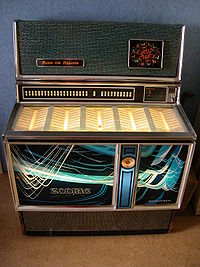|
Jukebox
A jukebox is a partially automated music-playing device, usually a coin-operated machine, that plays a patron's selection from self-contained media. The classic jukebox has buttons with letters and numbers on them, which are used to select specific records. Some may use compact discs instead. Disc changers are similar devices for home use; they are small enough to fit on a shelf and can hold up to hundreds of discs, allowing them to be easily removed, replaced, or inserted by the user. HistoryCoin-operated music boxes and player pianos were the first forms of automated coin-operated musical devices. These devices used paper rolls, metal disks, or metal cylinders to play a musical selection on an actual instrument, or on several actual instruments, enclosed within the device. In the 1890s, these devices were joined by machines which used recordings instead of actual physical instruments.[1][2] In 1889, Louis Glass and William S. Arnold invented the nickel-in-the-slot phonograph, in San Francisco.[3] This was an Edison Class M Electric Phonograph retrofitted with a device patented under the name of 'Coin Actuated Attachment for Phonograph'. The music was heard via one of four listening tubes.[4] In 1928, Justus P. Seeburg, who was manufacturing player pianos, combined an electrostatic loudspeaker with a record player that was coin-operated.[5] This 'Audiophone' machine was wide and bulky because it had eight separate turntables mounted on a rotating Ferris wheel-like device, allowing patrons to select from eight different 10" 78rpm records. Also in 1928, Homer E. Capehart and some backers founded the Capehart Automatic Phonograph Company, which brought out the Orchestrope. It was a device in which the tone arm slipped between each record in a vertical stack, playing that record on which the needle fell.[6] A similar system to Seeburg's Audiophone was employed by the Mills Novelty Company in their 1935 Dancemaster Automatic Phonograph. The Seeburg Symphonola "Trashcan" jukebox of 1938 holds 20 10" 78rpm records each in a shallow centreless drawer so that when the selected record's drawer opens, the turntable can rise through the open centre of the drawer to lift the record up to meet the pickup arm at the top of the mechanism, where it plays. Working examples of both these instruments may be seen and heard at the Musical Museum, Brentford, England.[7] Later versions of the jukebox included Seeburg's Selectophone with 10 turntables mounted vertically on a spindle. By maneuvering the tone arm up and down, the customer could select from 10 different records.[4] The word "jukebox" came into use in the United States beginning in 1940, apparently derived from the familiar usage "juke joint", derived from the Gullah word juke, which means "bawdy".[8] Manufacturers of jukeboxes tried to avoid using the term, associated with unreputable places, for many years.[9]
Wallboxes were an important, and profitable, part of any jukebox installation. Serving as a remote control, they enabled patrons to select tunes from their table or booth. One example is the Seeburg 3W1, introduced in 1949 as companion to the 100-selection Model M100A jukebox. Stereo sound became popular in the early 1960s, and wallboxes of the era were designed with built-in speakers to provide patrons a sample of this latest technology. Jukeboxes were most popular from the 1940s through the mid-1960s, particularly during the 1950s. By the middle of the 1940s, three-quarters of the records produced in America went into jukeboxes.[10] Billboard published a record chart measuring jukebox play during the 1950s, which briefly became a component of the Hot 100; by 1959, the jukebox's popularity had waned to the point where Billboard ceased publishing the chart and stopped collecting jukebox play data.[11]  As of 2016, at least two companies still manufacture classically styled jukeboxes: Rockola, based in California, and Sound Leisure, based in Leeds in the UK. Both companies manufacture jukeboxes based on a CD playing mechanism. However, in April 2016, Sound Leisure showed a prototype of a "Vinyl Rocket" at the UK Classic Car Show. It stated that it would start production of the 140 7" vinyl selector (70 records) in summer of the same year.[12][13] Since 2018, Orphéau, based in Brittany in France manufactures the original styled "Sunflower" Jukebox with the first 12" vinyl record selector (20 records), on both sides.[14] Notable models
DeclineTraditional jukeboxes once were an important source of income for record publishers. Jukeboxes received the newest recordings first. They became an important market-testing device for new music, since they tallied the number of plays for each title. They let listeners control the music outside of their home, before audio technology became portable. They played music on demand without commercials. They also offered high fidelity listening before home high fidelity equipment became affordable.[4] In 1995, the United States Postal Service issued a 25-cent stamp commemorating the jukebox.[17] Modern derivativesJukebox digital music players The term "jukebox" was used to describe high-capacity, hard disk based digital audio play due to their amount of digital space allowing a great number of music to be stored and played.[18][19] The term was popularised following the introduction of the Creative NOMAD Jukebox in 2000, which could store as many as 150 CDs of music on its six gigabyte hard drive.[20] In later years, the "classic" iPod would become the most popular product in this category.[18] Digital jukebox and appsWhile the number of traditional jukeboxes declined, digital jukeboxes, also called "social jukebox", have been introduced.[21] See alsoReferences
Further reading
External links
|



